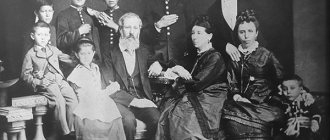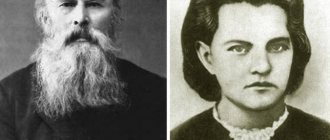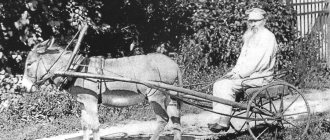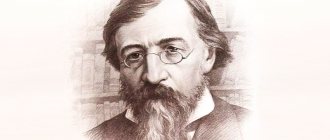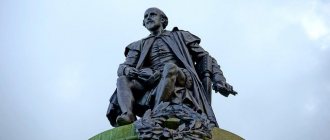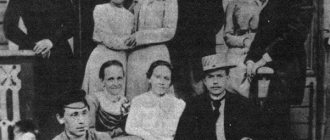Summary
Introduction
The author thanks God for the holy elder Sergius of Radonezh, who gives consolation to all believers. The author admits that one day he was overcome by “an irresistible desire to at least somehow begin to write, albeit a few of many, about the life of the Venerable Elder,” and he wrote “The Life of Sergius of Radonezh.”
The beginning of the life of Sergius
Sergius's parents were noble and virtuous people: father Kirill and mother Maria. One day, pregnant Mary went to church, where, at the sounds of the Cherubic song, her child “began to squeal loudly in the womb.” Mary realized that her child would be special, and “carried the baby in her womb like some priceless treasure, like a precious stone, like a wonderful pearl and like a chosen vessel.”
When the child was born, even in infancy he strictly observed fasts and refused mother's milk on Wednesdays and Fridays. The boy was named Bartholomew, he had two more brothers: the elder Stefan and the younger Peter. Bartholomew “studied slowly and poorly” and prayed to the Lord to teach and enlighten him.
About how Bartholomew was given the knowledge of literacy from God, and not from people
Bartholomew's parents were very sad that their son could not master literacy. One day the boy met “a certain monk, an old man unknown to him, holy and wonderful.” Bartholomew told the elder that “most of all he wants to know literacy,” but he cannot overcome it. The elder blessed the boy, and from then on he studied very well.
About adolescence
When Bartholomew grew up a little, he began to strictly observe fasts, and prayed a lot at night - “this is how the grace of the Holy Spirit infused him.” His mother tried to convince him to live like ordinary children, but Bartholomew was very persistent in his service to the Lord.
About the relocation of the saint's parents
The saint's father, Kirill, was a wealthy noble boyar and lived with his family in the Rostov region. But due to frequent Tatar raids on Rus', he quickly became impoverished and moved to Radonezh.
Bartholomew's brothers, Stefan and Peter, got married, and the young man “with all his soul strove for monastic life.” Having learned about this, the parents asked their son to look after them until his death, and then blessed him for monastic life. And so it happened.
About the tonsure of Bartholomew, which became the beginning of the monastic life of the saint
Before accepting monasticism, Bartholomew carefully “studied the entire monastic charter - both the monastic order and everything else that monks require.” Then the spiritual elder Mitrofan tonsured the young man, giving him a new name - Sergius. By that time the saint was twenty-three years old - “he was young in body, but in his spiritual mind he was old and perfect, by Divine grace.”
On driving away demons through the prayers of a saint
One day in the church where Sergius was going to sing matins, “the devil himself appeared with many demonic warriors.” But Sergius was not afraid: armed with the Cross of Christ, he began to read prayers - and “the devil and his demons became invisible, and they all disappeared and disappeared without a trace.” But after a while, the demons appeared again, and only thanks to Sergius’s fervent prayers were they able to disappear.
On the beginning of the saint's abbess
In the monastery of the Holy Trinity, Sergius fervently prayed to the Lord, but the devil did not give him peace and “with a sudden insidious attack he tried to turn Sergius’s thoughts away from prayer and virtuous works.” However, each time Sergius invariably dispersed “all his hostile ghosts.”
At the very beginning of Sergius's reign, there were twelve brethren in the monastery. This went on for several years, but over time, “the number of brethren began to increase more and more and exceeded twelve.”
About Ivan, son of Stefan
One day his elder brother Stefan came to Sergius with his son Ivan. Stefan asked the abbot to tonsure his son as a monk. Sergius agreed and tonsured his nephew, who received the name Fedor. “From a young age, Theodore was raised in all piety and purity and in fasting,” and the elders marveled at his sincere desire to serve the Lord from his youth.
About the abundance of everything you need
At first, “when the monastery began to get organized, it lacked a lot,” and the monks were deprived of the most necessary things. The monastery was located in a deserted place - there was not even a road to it, and for a long time people got to it almost at random. But over time, Christians fell in love with these places, and visitors regularly began to appear at the monastery, bringing everything “necessary for the life of the brethren.”
About the poverty of Sergius' clothes and about a certain peasant
Sergius wore very modest clothes, and his robe was “dilapidated, altered more than once, unwashed, soiled, soaked with much of his sweat, sometimes with patches.” The fame of Sergius spread very quickly, and many people wanted to look at the blessed one.
One day a peasant came to the monastery, who had long wanted to look at Sergius. Seeing the abbot in rags, he laughed contemptuously. However, Sergius accepted this attitude with humility.
Soon the prince and his retinue appeared at the monastery and, at the sight of Sergius, bowed low to the ground. And then the peasant realized that he had paid attention to the appearance, but not the essence of the person. Abbot Sergius forgave the peasant, “blessed him, consoled him with an edifying, soul-helping conversation, and sent him on his way.”
About the source
The monastery was founded in a deserted place, and the monks had to walk far to fetch water every day. They quietly grumbled about Sergius, who founded a monastery in such an unfortunate place. Then Sergius went down into the ravine, found a small ditch with water and began to pray earnestly over it. Having prayed fervently, the abbot “signed the sign of the cross over the place where the rainwater stood, and suddenly a full-flowing spring began to flow from under the ground, which continues to flow to this day.”
On the resurrection of a youth through the prayer of a saint
One day a sick little boy was brought to Sergius in the hope that he would heal the child from his illness with the power of his prayer. But while the peasant begged the saint to help, “the boy became exhausted from a severe attack of illness and gave up the ghost.”
Seeing the terrible grief of his father, Sergius began to pray earnestly over the body of the deceased child, and “suddenly, unexpectedly, the child came to life and began to move, his soul returned to his body.” So the abbot revived the child by the power of prayer.
About the possessed nobleman
The abbot also managed to heal a noble nobleman, who “was cruelly tormented by a demon day and night, so much so that he even broke iron chains.” The relatives of the nobles, having learned about the abbot, brought him to him possessed by a demon. Thanks to the prayers of the Reverend, the nobleman’s “reason returned and he began to speak intelligently.”
About the introduction of the hostel
Some time later, “Greeks, envoys of the Patriarch to the saint,” arrived to Sergius from distant Constantinople. Father Sergius was very surprised that the Patriarch knew about him, and at first he thought that this was some kind of mistake. The following was written in the message.
Message from Patriarch Philotheus
In his message to Father Sergius, the Patriarch blesses his service to the Lord and points out only one drawback - the lack of community life. The saint heeded the advice of Patriarch Philotheus, and soon a dormitory was equipped in the monastery. Father Sergius “commanded the brethren to firmly follow the commandments of the holy fathers: not to have any property and not to call anything their own, but to consider everything as common.” The hostel brought great benefits - from now on all “wanderers and beggars, especially the sick” could find shelter and a faithful piece of bread here.
About the foundation of the monastery on the Kirzhach River
After some time, “confusion occurred again in the monastery”: the monks, prompted by the devil, decided to overthrow the abbot of Sergius. Then the saint left the monastery and went in search of a deserted place. Soon he found him on the banks of the Kirzhach River. Having received the blessing of Metropolitan Alexy, he began building the church.
Soon the monks realized how wrong they were and asked Father Sergius to go back. He agreed, and “everyone unanimously rejoiced and glorified God for the return of their spiritual father.”
About Bishop Stefan
One day, Bishop Stefan, driving past the monastery of Father Sergius, wanted to visit the saint, but did not have time to do so. He only read “the prescribed prayer and bowed to Saint Sergius - on the other side where the blessed one’s monastery was located.” However, the Reverend saw with “spiritual eyes” what Bishop Stephen did, and to the great surprise of his brethren, he stood up in the middle of the meal and bowed in response.
The beginning of the Simonov Monastery
The nephew of Father Sergius, the youth Fedor, “led a virtuous life, being in complete obedience to the saint and exhausting his body with strict abstinence, so that many marveled at him.” Seeing Fyodor’s zeal in serving the Lord, Father Sergius entrusted him with the construction of a monastery in the place of Simonovo, located not far from the Moscow River. Having received a blessing from the bishop, Fyodor erected “a church in the name of our Most Pure Lady Theotokos, Her venerable Nativity.”
About the vision of an angel serving with blessed Sergius
Once, during the liturgy, a strange-looking clergyman was noticed near Saint Sergius - he was dressed in shining vestments and shone with an extraordinary light. No one knew this, the clergy, and then “the monks truly understood that an Angel of God served Saint Sergius.”
About the victory over Mamai and the monastery on Dubenka
When it became known that “the Horde prince Mamai gathered a huge army - the entire horde of godless Tatars - and went to the Russian land,” Grand Duke Dmitry turned to Father Sergius for help. The saint blessed the prince and armed him with prayer. On the battlefield, the prince saw a countless horde of Tatars and doubted victory. But at that moment a messenger arrived from Father Sergius, who assured the prince of a brilliant victory. Encouraged by such words, Prince Dmitry and his squad rushed into battle, and “the filthy Tatars were defeated and were completely defeated.”
About how they wanted to elevate a saint to the metropolis
When Metropolitan Alexy felt his imminent death, he called St. Sergius to him and asked him to lead the metropolis. However, Father Sergius refused such a high honor, since from his youth “he was not a gold-bearer” and would like to live in his old age in poverty. Father Sergius was adamant in his decision, and another person ascended to the episcopal throne.
About Our Lady's visit to the saint
One day the Reverend prayed before the icon of the Mother of God and soon “saw the Most Pure One with two apostles, Peter and John, from whom also emanated an indescribable radiance.” The Mother of God touched Father Sergius and said that his prayer for the disciples and the monastery had been heard, and from now on the monastery of the Saint “will have abundance in everything.”
About the bishop who came to see the saint
Some time later, a bishop came to Father Sergius from Constantinople, who had long heard about the wonderful old man. He did not believe that the Reverend was a “truly man of God,” and at the sight of him he suddenly became blind. Then Father Sergius said that the illness would go away the moment the bishop gained firm faith. And so it happened. The bishop returned home, “glorifying God and His holy saint Sergius.”
About a man healed through the prayers of St. Sergius
Not far from the monastery of the Monk there lived a man who was struck down by a terrible illness, and “for twenty days he could neither eat nor sleep.” Saint Sergius sprinkled the sick man with water, read a prayer - and he was healed. The man went home, “with all my heart thanking God, who works wondrous and indescribable miracles through His saint.”
About the covetous
Not far from the monastery lived “a man distinguished by strong greed.” He committed a bad act: he took a pig from an orphan neighbor and slaughtered it without paying money. The offended man asked Father Sergius to intercede for him, and he, calling the offender, punished him to return the money for the pig. The miser did not comply with this requirement and upon returning home he saw a pork carcass in which worms were swarming. He was very afraid of God's wrath and returned the money to his neighbor.
About the repose of the saint
Father Sergius lived 78 years “in perfect abstinence and labor and was honored for his exploits with inscrutable and unspeakable miracles.” When he died, “a strong, indescribable fragrance spread from the saint’s body.” Having lost their teacher, the brethren fell into deep sorrow. At the death of the Reverend, many miracles occurred that continue to happen today - “the members of the paralytic are strengthened, people are freed from demons, the blind receive their sight, the hunchbacked are straightened.”
On the discovery of the relics of St. Sergius
Thirty years after the death of Father Sergius, one of the Christians had a vision in which the Reverend asked to get his relics out of the ground. In front of a large crowd of people, the coffin with the relics of Father Sergius was opened, and “everything around was filled with fragrance and a subtle aroma, and everyone saw a wonderful and touching sight: not only the saint’s honest body was preserved whole and bright, but also the clothes in which he was buried , turned out to be intact.” The healing relics of the saint were placed in a shrine, where they remain to this day.
On the repose of the Venerable Abbot Nikon
Some time later, the disciple of Saint Sergius, the Venerable Nikon, died. Before his death, he “called on the brethren and gave the monks useful instructions: so that they adhere to their father’s traditions with all possible zeal, immutably, and have unfeigned love for everyone.” He found his last refuge next to his blessed father.
About how they saw Saint Sergius among the brethren while singing
Once, after the death of the monk, the monk saw the elder in the likeness of a living person at an all-night vigil - “The monk stood in his place and sang along with everyone.” This news made the brethren very happy.
About the appearance of Metropolitan Alexy together with Saint Sergius
Over time, the monastery of the Monk began to expand, as the brethren increased significantly. One day, “a student of Abbot Nikon was cutting down a tree to build a cell” and injured his face with the edge of an ax. The unfortunate man was bleeding and so weak that he could not call for help. Suddenly, a “luminous old man” appeared, followed by another person. The patient mentally received a blessing from them and was healed. Later he learned that Father Sergius and Metropolitan Alexy visited him.
About a certain Tver nobleman Zacharias
One day, a noble nobleman named Zechariah had a pain in his insides - “his stomach increased day by day, so that the nobleman was in danger of death.” Having great faith in Saint Sergius, he began to “eat bread from the meal from the monastery of the Venerable One.” Thanks to the prayers of the saint, he was completely healed. The nobleman vowed to come to the monastery and give thanks for the healing, but he never kept his word.
The second miracle is about the same thing
After a while, the same nobleman Zacharias had a severe toothache, so much so that he “could neither eat nor sleep for many days from the pain.” At night, when everyone was sleeping, Father Sergius appeared to him, who took the sick man to his monastery and healed him there. The nobleman immediately went to the monastery of the Monk himself and, as a token of gratitude, made a large donation to the brethren.
About a warrior delivered from the filthy
One day there was an “invasion of the godless Tatars” led by Khan Mahmet. Many Orthodox Christians were killed in the battle with the Tatars. One of the strong Russian warriors almost lost his head, but at the very last minute he remembered Saint Sergius and began to pray fervently. At the very first words of the prayer, “his horse took off at a gallop, as if it had acquired wings, so that the filthy ones lost sight of him.”
Miracle of the Blind
One day a blind wanderer was brought to the monastery of the monk, who had been traveling around the world blind for seven years. On this day there was a holiday - the Descent of the Holy Spirit. Saint Sergius descended from heaven to the blind man, led him to the shrine, and the sufferer immediately received his sight.
About the possessed youth
A young man lived in the monastery, tormented by an unclean spirit. He was tied tightly, but he invariably broke the bonds, ran away to the cliffs and often crashed. Near the coffin of the Reverend, he writhed in agony, and nothing helped him overcome the demon. The brethren fervently poured out prayers for him, and after a while the Lord “drove away the unclean spirit, through the prayers of Saint Sergius, and the young man was healed, his mind returned to him, as if he had never been sick.”
About the presbyter and the men who were in the Latin lands
When Metropolitan Isidore went to the Council to the Pope, he took Presbyter Simeon with him. However, he did not want to submit to Latin authority, “and therefore suffered from Isidore for the Orthodox faith great sorrows and torments in prison, in shackles and chains.” Simeon managed to escape along with the Tver ambassador Foma, and on the way home they more than once found themselves on the brink of danger. But each time they were rescued by the intercession of Saint Sergius, to whom they prayed tirelessly.
The Miracle of the Nun Mariamia
One day, nun Mariamia came to the monastery, whose hands “withered from illness, were bent at the elbows behind her back and pressed to her ribs with her nails.” Thanks to her prayers to the saint, her hands became completely healthy. This miracle happened in front of a large number of people, so everyone was amazed at it.
Miracle of the miraculous conception and birth of Grand Duke Vasily Ivanovich of All Rus', autocrat
Grand Duke Ivan Vasilyevich passionately dreamed of an heir, but only daughters were born to him. Then his wife, Princess Sophia, set off on foot from Moscow to the monastery of St. Sergius. On the way, she met a “grand monk with a baby in his arms” - he turned out to be Saint Sergius. He gave the baby to the princess and immediately disappeared. Sophia realized that it was a vision. Having reached the monastery, she fervently prayed to the Reverend for her desire. After the allotted time, the princess successfully “conceived in her womb a God-given heir to the Russian throne.”
Miracle of St. Sergius the Wonderworker about the glorious victory over Lithuania near the city of Opochka
One day, the Lithuanian king sent a well-armed army “to the city of Opochka, which is not far from Pskov, wanting to ruin it.” Residents of the city bravely fought the enemies, but soon they ran out of stones, which they dumped on the heads of the adversaries. Then at night Saint Sergius appeared to one woman and said that “many stones lie in the ground near the city church behind the altar.” She told the townspeople about this, and with the help of these stones they were able to defeat the enemy.
About the appearance of St. Sergius in the city of Kazan
In those days when Kazan was ruled by “filthy infidels,” an old man suddenly appeared in the city, covering the city walls with crosses and sprinkling with holy water. The Gentiles realized that the end of their power had come, and “soon the Christian faith will shine here.” And so it soon happened: Grand Duke John Vasilyevich went to war against Kazan and annexed the city to the Russian land.
About the miracles of the Venerable Wonderworker Sergius, which took place in his monastery during the siege
In the monastery lived “a certain old man named Irinarh, who served as a sexton.” One day Father Sergius appeared to him, warned him of an imminent attack by enemies and advised him not to be afraid of his adversaries. Irinarch walked around the entire monastery and sprinkled it with holy water. The next night, warriors attacked the monastery, but the brethren managed to repel the attack “through the prayers of the miracle worker.”
About the appearance of St. Sergius the Wonderworker to Lithuanian soldiers
When the enemies began to overcome the brethren, “God brought fear to the enemies, through the prayers of St. Sergius the Wonderworker” - the Lithuanian soldiers suddenly saw a countless horde of soldiers emerging from the gates of the monastery. The enemies were frightened by this vision, and the brothers, sensing God's help, were able to defeat the adversaries.
About the multiplication of loaves at the Trinity Metochion - in the Monastery of the Holy Epiphany in Moscow
During the enemy siege, the people began to suffer from hunger. Then everyone began to diligently glorify Saint Sergius, and soon a miracle happened at the Trinity Metochion - the monk noticed “rye pouring out of the wall through a hole.” People ate this bread as long as the siege lasted.
Religious activities
A few years later, a thriving temple of St. Sergius of Radonezh - the Trinity-Sergius Monastery - was formed in this place. Having learned about the establishment of the monastery, Ecumenical Patriarch Philotheus sent the abbot a letter in which he paid tribute to his activities. St. Sergius was a highly respected person in princely circles: he blessed rulers before battles and tried them on among themselves.
In addition to the Trinity-Sergius, during his short biography, Radonezh founded several more monasteries - Borisoglebsky, Blagoveshchensky, Staro-Golutvinsky, Georgievsky, Andronnikova and Simonov, Vysotsky.
The great hieromonk Sergius died on September 25, 1392.
Description and meaning of the icon
Sergius of Radonezh is the most revered saint in Orthodoxy. His first image was made on a sewn cover back in the 20s of the 15th century. In those days, his image was painted on liturgical utensils. In subsequent years, the Venerable Elder was depicted on hagiographic icons. In the center of such images a saint was drawn, and in the margins, in the stamps, there were scenes from his life.
There are icons with 19 and 17 marks, each of which tells about the miracles and deeds of the hieromonk.
Usually Sergius of Radonezh is depicted as a gray-bearded old man with a scroll in his left hand, while his right hand is raised for blessing. Such an image means that the saint understands the sinfulness of man and asks everyone to repent of their sins. Sergius devoted his entire life to monasticism and the unity of the Russian lands. His icon recalls the feat of the saint, and Father Sergius himself is an example of integrity, faith in God, patience and meekness.
What do they pray to the saint for?
Believers consider Father Sergius a miracle worker and a saint. In their prayers, they ask the Reverend Elder to help them in worldly affairs, protect them from evil influences, and heal their body and soul.
Studies
Father Sergius helps with studies, before sessions and exams. The saint hears the prayers of everyone who prays and turns to him. You need to say in front of the icon: “Reverend Father Sergius, pray to God for me!” Before exams, it is advisable to go to church, pray and light a candle to the saint.
Litigation
Believers turn to the saint on the eve of trials. During his lifetime, Father Sergius stood up for the weak and helped them in the struggle for justice. Prayer to his divine face gives self-confidence to all who fight for the truth in the courts.
Quieting Pride
St. Sergius can help in prayers for the granting of humility and the taming of pride. When turning to the Reverend Elder, you need to repent of your sins and ask him to pray before God for your sinful soul.
Healing
Mothers turn to the Reverend Elder and ask him to heal the child. The saint is a mediator between people and the Almighty. Orthodox believe in the intercession of Sergius. Christians pray to him and ask him to grant health to themselves, their children, and their loved ones.
Protection
Prayer to Saint Sergius protects the house from enemies, and the soul from evil thoughts and passions. The elder served his native Fatherland all his life, strengthened the princes’ faith in God before battles, and sent monks to defend the land and fight the Tatars. Sergius always trusted in God’s help and received it in difficult times. His life is an example for all Christians.
Job
Sergius of Radonezh worked all his life. Believers turn to him so that in prayers to the Lord the holy elder will help them overcome life's difficulties. Sergius gives Christians faith in their own strength, encourages them not to be afraid of any work, and helps them get a new job.
Peace of mind
Fervent prayer to the holy elder helps to get rid of sinful thoughts, calm the soul, and find peace of mind. Sergius of Radonezh believed that faith in the Lord God and observance of his commandments help to live a righteous life and not sin. He taught his students humility and tolerance. Believers turn their requests to the Reverend Elder in the most anxious days of their lives.
The emergence of a monastery around the hermit Sergius of Radonezh
He lived so quietly and brightly that soon the forest animals ceased to be afraid of this amazing man. It seems that Bartholomew began to understand the wordless language of the animals that became his ingenuous neighbors.
The chronicles say that even a clubfooted forest giant, a bear, came to Bartholomew, with whom the saint shared both his meager food and his kind words. Over the years of his solitary life, Bartholomew became convinced of the correct path of the hermit and took monastic vows - he became a monk and took the monastic name Sergius.
Soon rumors spread about the amazing hermit Sergius of Radonezh. Monks flocked to Makovets, who, like him, wanted a quiet, secluded life away from the bustle of the world. So a modest monastery arose around the ascetic. At first there were only twelve monks - according to the number of holy biblical apostles. Only with great difficulty did they manage to persuade Sergius to become abbot - to accept seniority over them.
He established strict rules for the community: he strictly forbade asking for alms and ordered them to live only by the fruits of their labors. He set an example himself - from morning to evening he was busy with the housework: chopping wood, carrying logs, carrying water in buckets from a source for the brethren, baking prosphora and brewing kvass, sewing clothes and shoes himself, while still managing to say prayers and roll wax candles for the church . They say that the peasants who came to look at the great ascetic did not immediately recognize him as a ragged old man humbly digging the beds.
Meanwhile, the settlement of hermits grew and over time turned into a small monastery. Peasants began to settle around, cultivated fields, hayfields, and apiaries appeared. Thus, Sergius, who fled from the unjust dark world, through his asceticism, began to create a different, bright life around himself. In his monastery, Sergius introduced rules of common life. According to them, all the monks within the walls of his monastery were equal to each other, wore the same clothes and ate from a common cauldron. By their example, they showed people a community of workers, each of whom cared about the common good and performed holy prayer for the glory of the Lord.
Following the example of the Trinity Monastery on Makovets, Sergius’s disciples began to create other monastic monasteries. More than forty monasteries arose in this way in Rus' at that time. And people began to settle near the monastery buildings.
When an icon is venerated
The memory of the life of the Reverend is alive to this day. The saint is remembered by the clergy, because thanks to him many monasteries were opened in Russian lands. Father Sergius contributed to the strengthening of Orthodoxy in Rus'. The Church remembers the hieromonk twice every year. The first time was in the summer on July 18, on the day of the discovery of his relics. The holiday is dedicated to the removal of remains from a flooded grave and their transfer to a safe place in a new church. Since the 15th century, Orthodox Christians have celebrated the death of the abbot every year on October 8th. On memorial days, a festive service is held in churches in honor of St. Sergius. The clergy and believers sing the troparion to the hieromonk.
During his lifetime, Father Sergius was very wise, kind, and educated. He advocated the unification of Rus', called on the princes not to fight each other, but to unite and oppose the Tatars. Sergius blessed believers with family happiness, love and fidelity. Lonely people turn their prayers to him, he helps them find their soul mate and happiness.
An icon depicting a saint should be in every home. It helps you become more tolerant, kinder, smarter. True, to find happiness and peace of mind, you need to repent of all your sins, sincerely ask God to save your sinful soul and put you on the right path.
Relocation to Radonezh
And so it happened. Bartholomew grew up in a difficult time for Rostov, and for all of Rus'. Another memorable thing was the brutal destruction of the city by the Mongols. They crushed the Russians with a heavy tribute, did not allow them to breathe or straighten their shoulders freely. But Rostovites suffered not only from the Mongol yoke.
In Moscow, power was taken by Ivan Kalita, who, having married his daughter to the Rostov prince, began to interfere in his affairs. He sent his nobles to Rostov, who were worse than the Tatars in extracting the last from the people. The city became poor, and the neighboring villages declined with it. It was not because of a good life that Bartholomew’s parents had to leave their homes in 1328 and move to a new home - in Radonezh, in a remote corner of the forest, where greedy champions had not yet reached.
Looking at the ruin and lack of human rights, Bartholomew dreamed of a solitary life in which he alone would work before God, say his silent prayer to him and glorify him with the daily labors of a hermit. For the time being, only his filial duty kept him from this dream. Brothers Stefan and Peter were already married and lived on their own farm. Who else will take care of his aging parents? Bartholomew was with them until the end of their lives.
Solitude on the banks of the Konchura River
After the death of his parents, he ceded his part of the inheritance to his brother Peter and went to the surrounding forests to look for places to live in the desert. Next to him was his brother Stefan. His wife had recently died, and the widower, yearning for her, wanted to ease his grief by living as a hermit. The brothers chose Makovets Hill, on the banks of the Konchura River, as the site of their secluded settlement. Here, in the middle of the remote Radonezh forest, they cut down a small church in honor of the Holy Trinity.
The life of a forest hermit is easy and hard. It’s easy, because there is no injustice or grief nearby, only the silence of the centuries-old forest all around. It is difficult because there is no human help in daily deeds and prayers; a crumb of warmth and meager food - everything has to be obtained with one’s own hands. Bartholomew finds joy in his hardships—he does every work he does tirelessly and for the glory of God. However, Stefan's years are making themselves felt; the life of an ascetic turned out to be too hard for him. Over time, he had to leave his brother and go to the Moscow Epiphany Monastery. So Bartholomew was left completely alone in the forest.
How to pray correctly
Believers must pray. It is better to read ready-made prayers written by saints. Such people have been praying alone for decades; they know what to ask the Lord God for. After all, prayer is not a desire that believers ask the Almighty to fulfill, but repentance of their own sins, a request for help and guidance on the true path.
St. Ephraim the Syrian said that people do not know what to pray for, they do not know what is useful for them, what they need to ask God for in prayers. The Almighty already knows all the problems of Christians. He will help save a sinful soul if a person repents of his sins and reads prayers written by holy people.
Interesting Facts
- The Life of Sergius tells that Bartholomew learned to read and write thanks to the blessing of the holy elder.
- Among the students of Sergius of Radonezh were such famous religious figures as Abraham of Galitsky, Pavel Obnorsky, Sergius of Nuromsky, Venerable Andronik, Pachomius of Nerekhta and many others.
- The life of the saint inspired many writers (N. Zernov, N. Kostomarov, L. Charskaya, G. Fedotov, K. Sluchevsky, etc.) to create works of art about his fate and deeds, including a number of books for children. The biography of Sergius of Radonezh is studied by schoolchildren in grades 7-8.
Previous
BiographiesBrief biography of Sholokhov interesting facts and works of Mikhail Alexandrovich
Next
BiographiesDj Groove brief biography of the DJ
Examples of Prayer
You need to ask Sergius of Radonezh for help and intercession by reading prayers according to the prayer book. Only such speeches are heard by the hieromonk and the Lord God.
About adding intelligence
In this prayer St. Father Sergius is asked to hear the requests addressed to him and to convey them to the Most Immaculate Mother of God herself. After all, after death the saint approached the Heavenly Powers. Believers assure Father Sergius of their love for God and worship of his holy relics. They ask for help in overcoming the granite of science, adding intelligence, removing the scales from the eyes and opening the mind to the truth.
Before the exam
In this appeal to Father Sergius, believers ask him to lead them to heavenly heights. Christians pray to deliver them from cowardice, to confirm them in faith and devotion to God. Believers ask St. Sergius to pray on their behalf to the Most High. Christians believe in the intercession of the saint at the Last Judgment and repent of their sins.
Defense of the Fatherland from Infidels
In this prayer, believers ask the Saint to pay attention to them, to look down from the heights of heaven at sinful people. Christians will assure Father Sergius of his love for God, asking him to enlighten them in days of difficult trials, to give them strength and courage to withstand the battle with their enemies.
Troparion
This song says that from early youth, Father Sergius loved the Almighty with all his soul. He retired from the bustle of the world, went into the distant desert to pray to the Lord God and live according to his laws. Father Sergius founded a monastery in which he prayed to the Savior for sinful souls. People came to him from everywhere for faith and healing, he helped everyone find peace of mind and strengthen their faith in God.
First
In this prayer, believers turn to Father Sergius, calling him Holy, Reverend, God-Bearing. Christians believe in his ascension to heaven after death and that he communicates with the Mother of God herself. Believers ask them to love, to pray for the salvation of their sinful souls, to intercede for them before the Almighty and the Virgin Mary.
Second
Christians make this request to Father Sergius. They ask him not to forget the unfortunate, to remember them in his prayers to the Almighty. Believers assure Father Sergius of love and respect. They ask to convey their prayers to the Lord God himself, not to remain silent about their requests and to pray for the salvation of sinful souls.
Third
In this petition Rev. Father Sergius is asked to graciously look down from heavenly heights and see all those asking. Believers understand that they are far from the holy elder, not only in the literal, but also in the figurative sense. After all, they are sinners, so they ask to bring them to reason, to guide them on the true path, to convey their prayers to the Lord God himself, to forgive their sins and not to abandon them in difficult times.
Where are the icons located?
The Venerable Father Sergius is depicted on single and hagiographic icons. He was often depicted at full length in a cassock, because he was a monk all his life. In the hagiographic icons, artists painted an image of Father Sergius in the center, and about 17-20 scenes from his life along the edges. In each mark you can see what the hieromonk did - he healed the sick, prayed, blessed the soldiers for victory.
In the Holy Trinity Lavra of Sergius in the Moscow region, in Sergiev Posad, there are the relics of the saint. The remains and holy icon of the hieromonk are available in the courtyard of the Trinity-Sergius Lavra in the Church of the Life-Giving Trinity, as well as in the Church of St. Nicholas in Klenniki, in the Moscow Church of Elijah the Obydeniy. In the village of Bibirevo, in the Church of St. Sergius, there is an ancient icon that commemorates salvation from cholera in the 19th century. The collection of the Andrei Rublev Museum contains an icon of the hieromonk with 17 marks of his life. An image of the saint is found in almost every church.
Sergius of Radonezh in the unification of Rus'
With his quiet and wise words, Sergius of Radonezh reconciled the warring Russian princes and persuaded them to voluntarily submit to the Grand Duke of Moscow. The word of the righteous turned out to be stronger than weapons.
Largely thanks to the efforts of Sergius of Radonezh before the Battle of Kulikovo, all Russian soldiers united under the leadership of Dmitry Donskoy.
Before the decisive battle, Dmitry Ioannovich himself came to Makovets to Sergius, prayed with him and received his blessing. Having broken his monastic vow not to take up arms in order to save the Motherland from its enemies, Sergius sent two of his monks, Peresvet and Oslyabya, with the commander. According to legend, both of them fell in the battle, which ended in a glorious victory over the army of Mamai on the day of the Nativity of the Virgin Mary. Ancient texts say that the Most Pure Virgin herself once appeared to Sergius in the radiance of light, having heard his prayers for his disciples and the monastery he created.
